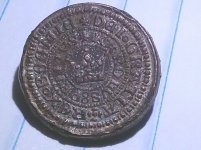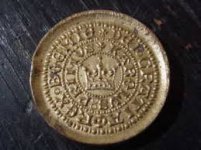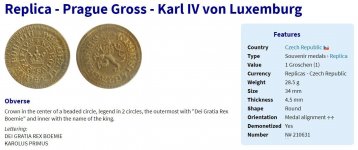marty persall
Newbie
- Aug 19, 2014
- 4
- 7
- Detector(s) used
- Currently Whites Treasure/ With Audiovox Bluetooth Headphones.
Backup. Garrett Groundhog.
- Primary Interest:
- All Treasure Hunting
Medieval Coin Found In Oklahoma ?
Let me be more clear, I found the coin pictured on the left, the picture on the right is for reference only.
thanks guys for your input.
Czech coin minting reform was introduced by Wenceslaus II (1278 to 1305AD). Thanks to rich deposits of silver in Kutna Hora, Prague groschen became a substitute for still circulating dinars and brektty.
These are silver coins which weigh near 4 grams with fineness around 0.930. Prague groschen over the centuries show a stylized image of a crown and, on the other side, a crowned two-tailed lion. Names of individual rules appear on the inner circle of the crown side, with DEI GRATIA REX BOHEMIA on the outer circle. There is a good summary of these coins at stribrnak.cz.
WENCEZLAVS SECUNDUS 1278-1305
PRIMUS IOHANNES 1310-1346
PRIMUS KAROLUS 1346-1378
WENCEZLAVS TERCIUS 1378-1419
PRIMUS LADISLAVS 1453-1457
PRIMUS GEORGIUS 1458-1471
WLADISLAVS SECUNDUS 1471-1516
PRIMUS LUDOVICUS 1516-1526
FPRIMUS FERDINANDUS 1526-1564
Let me be more clear, I found the coin pictured on the left, the picture on the right is for reference only.
thanks guys for your input.
Czech coin minting reform was introduced by Wenceslaus II (1278 to 1305AD). Thanks to rich deposits of silver in Kutna Hora, Prague groschen became a substitute for still circulating dinars and brektty.
These are silver coins which weigh near 4 grams with fineness around 0.930. Prague groschen over the centuries show a stylized image of a crown and, on the other side, a crowned two-tailed lion. Names of individual rules appear on the inner circle of the crown side, with DEI GRATIA REX BOHEMIA on the outer circle. There is a good summary of these coins at stribrnak.cz.
WENCEZLAVS SECUNDUS 1278-1305
PRIMUS IOHANNES 1310-1346
PRIMUS KAROLUS 1346-1378
WENCEZLAVS TERCIUS 1378-1419
PRIMUS LADISLAVS 1453-1457
PRIMUS GEORGIUS 1458-1471
WLADISLAVS SECUNDUS 1471-1516
PRIMUS LUDOVICUS 1516-1526
FPRIMUS FERDINANDUS 1526-1564
Attachments
Last edited:
Upvote
6










